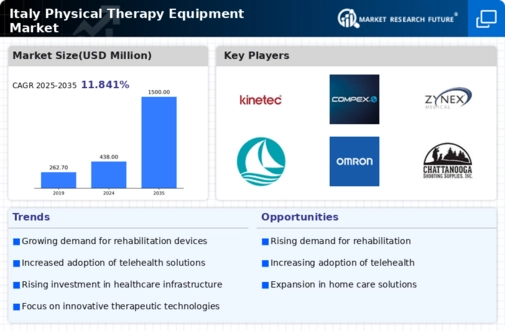Focus on Preventive Healthcare
The emphasis on preventive healthcare in Italy is reshaping the physical therapy-equipment market. As healthcare policies increasingly prioritize prevention over treatment, there is a growing recognition of the role of physical therapy in maintaining health and preventing injuries. This shift is likely to drive demand for equipment that supports preventive measures, such as strength training and flexibility exercises. By 2025, it is projected that the market for preventive physical therapy equipment could grow by 10%, reflecting the changing attitudes towards health management. Consequently, the physical therapy-equipment market is expected to adapt by offering products that cater to this preventive approach, thereby enhancing overall public health outcomes.
Emergence of Innovative Therapies
The emergence of innovative therapies is significantly influencing the physical therapy-equipment market in Italy. New treatment modalities, such as robotic-assisted therapy and virtual reality rehabilitation, are gaining traction among healthcare providers. These innovative approaches not only enhance patient engagement but also improve recovery outcomes. As these therapies become more mainstream, the demand for specialized equipment is likely to increase. By 2025, the market for innovative physical therapy equipment is expected to expand by approximately 12%, driven by advancements in technology and a growing body of evidence supporting their efficacy. This trend suggests that the physical therapy-equipment market will continue to evolve, incorporating cutting-edge solutions to meet the needs of modern rehabilitation.
Integration of Digital Health Solutions
The integration of digital health solutions into the physical therapy-equipment market is transforming the landscape of rehabilitation in Italy. Telehealth services and mobile applications are increasingly utilized to monitor patient progress and provide remote consultations. This shift towards digitalization is expected to enhance the efficiency of physical therapy practices, allowing for more personalized treatment plans. By 2025, it is estimated that around 30% of physical therapy sessions may incorporate digital tools, indicating a significant shift in how therapy is delivered. The physical therapy-equipment market is likely to adapt to these changes by offering equipment that is compatible with digital platforms, thereby improving patient engagement and adherence to therapy regimens.
Rising Demand for Rehabilitation Services
The physical therapy-equipment market in Italy experiences a notable increase in demand for rehabilitation services. This trend is driven by a growing awareness of the importance of physical therapy in recovery processes. As the population becomes more health-conscious, the need for effective rehabilitation solutions rises. In 2025, the market is projected to grow by approximately 8% annually, reflecting the increasing reliance on physical therapy for post-surgical recovery and injury rehabilitation. This demand is further fueled by the expansion of outpatient rehabilitation facilities, which are becoming more prevalent across the country. Consequently, the physical therapy-equipment market is likely to benefit from this rising demand, as healthcare providers seek advanced equipment to enhance patient outcomes.
Increased Investment in Healthcare Infrastructure
Investment in healthcare infrastructure in Italy is a critical driver for the physical therapy-equipment market. The government and private sector are allocating substantial funds to enhance healthcare facilities, which includes upgrading rehabilitation centers. In 2025, it is anticipated that healthcare spending will increase by 5%, with a significant portion directed towards modernizing physical therapy departments. This investment not only improves the quality of care but also stimulates demand for advanced physical therapy equipment. As facilities expand and modernize, the physical therapy-equipment market is poised to grow, providing innovative solutions that meet the evolving needs of healthcare providers and patients alike.

















Leave a Comment